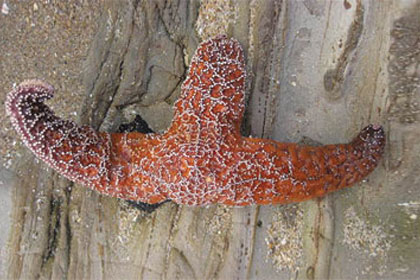Sea stars along much of the Pacific coast of North America are experiencing a mass mortality called sea star wasting syndrome. Early signs of the syndrome can include a “deflated” appearance, unnatural twisting, or small lesions on the surface that may increase in size and number. Wasting syndrome can progress rapidly, and often leads to loss of arms, softening of tissue, and eventual death just a few days after external signs become visible. Although similar sea star wasting events have occurred previously, a mortality event of this magnitude, with such broad geographic reach has never before been documented.
Wasting syndrome was first noted in ochre stars (Pisaster ochraceus) in June 2013 along the Washington coast during monitoring surveys conducted by researchers from Olympic National Park. ONP is part of a west coast-wide, long-term monitoring effort–the Multi-Agency Rocky Intertidal Network (MARINe), thus researchers from Alaska to California were quickly alerted to the emergence of the syndrome. Indeed, the majority of wasting syndrome-related observations are for ochre stars (the most common sea star in the intertidal). Other species affected include Evasterias troschelii (mottled star), Dermasterias imbricata (leather star), and Leptasterias spp (six-armed star). As of December, signs of wasting had been observed at 45 of 84 MARINe sites sampled since summer 2013, spanning the entire coast from Alaska to San Diego but varying in intensity from low levels of infection to mass mortality. Large gaps in available information hinder efforts to understand the outbreak.
In August, divers reported massive die-offs of the sunflower star, Pycnopodia helianthoides, just north of Vancouver, British Columbia and shortly thereafter, other sea star species in the region began showing signs of wasting. During October/November, a similar mass mortality event was documented in Monterey, CA, beginning with sunflower stars, then emerging in other species days to weeks later. As of mid-December, substantial numbers of sea stars with wasting syndrome were reported from southern California. Subtidal observations have thus far been largely opportunistic, and highly regional. Efforts are underway to standardize and coordinate a sampling approach, to better document the distribution of wasting syndrome in the subtidal and identify patterns of spread.
In nearly all subtidal wasting events documented during 2013, the sunflower star, Pycnopodia helianthoides is the first species to succumb to the disease. Other species affected (listed roughly in order of when signs of wasting first appear) include: Orthasterias koehleri (rainbow star), Pisaster brevispinus (giant pink star), Pisaster giganteus (giant star), Evasterias troschelii (mottled star), Pisaster ochraceus (ochre star), Solaster spp. (sun star), Dermasterias imbricata (leather star), Mediaster aequalis (vermilion star), Leptasterias spp (six-armed star), and Patiria miniata (bat star). It is unknown whether the disease spreads sequentially from one species to the next or if some species simply take longer to express symptoms. Two species for which massive, geographically expansive (but patchy) declines have been well documented are the sunflower and ochre stars. Other species are less abundant, and thus impacts of wasting syndrome are less clear.
Ecologists consider sunflower and ochre stars to be keystone species because they have a disproportionately large influence on the distribution and abundance of many other species. Scientists anticipate that such a large mortality event in keystone species could change the intertidal and subtidal seascapes. Scientists are working hard to understand the causes and consequences of the event. Previous examples of large-scale, mass mortality of individual marine species have resulted in dramatic ecosystem-wide changes.
How You Can Help
Numerous universities, government agencies, aquariums, and citizen scientists have been involved in this large collaborative effort and are listed at www.seastarwasting.org. Work is underway to launch citizen science projects to help researchers map the spread and distribution of the disease in different sea star species and in different regions. For information about coordinated surveys being done, and the coast-wide Sea Star Wasting Tracking Map visit www.seastarwasting.org.
Sources: University of California Santa Cruz









